Cloud Computing in Healthcare: Implementation and Evaluation Report
VerifiedAdded on 2021/06/17
|23
|6365
|38
Report
AI Summary
This report analyzes the integration of cloud computing in healthcare, addressing business problems and opportunities. It emphasizes the shift towards consumer-driven healthcare, increased efficiency, and reduced costs. The report explores the benefits of cloud computing, including improved patient care, remote medical access through telemedicine, and the use of AI for data analysis. It outlines project stakeholders, scope, and requirements, including the implementation of electronic health records, big data analysis, and telemedicine. The current state of healthcare is compared to the potential of cloud computing, highlighting limitations in accessibility and data management. The report details the IT configuration, requirements analysis, selection criteria, and evaluation processes for implementing cloud solutions, including impact and process evaluations. The report also discusses the importance of stakeholder communication and outlines the key considerations for the tendering process.

CLOUD COMPUTING IN HEALTHCARE
By
(Name)
(Course)
(Professor’s Name)
(Institution)
(State)
(Date)
By
(Name)
(Course)
(Professor’s Name)
(Institution)
(State)
(Date)
Paraphrase This Document
Need a fresh take? Get an instant paraphrase of this document with our AI Paraphraser
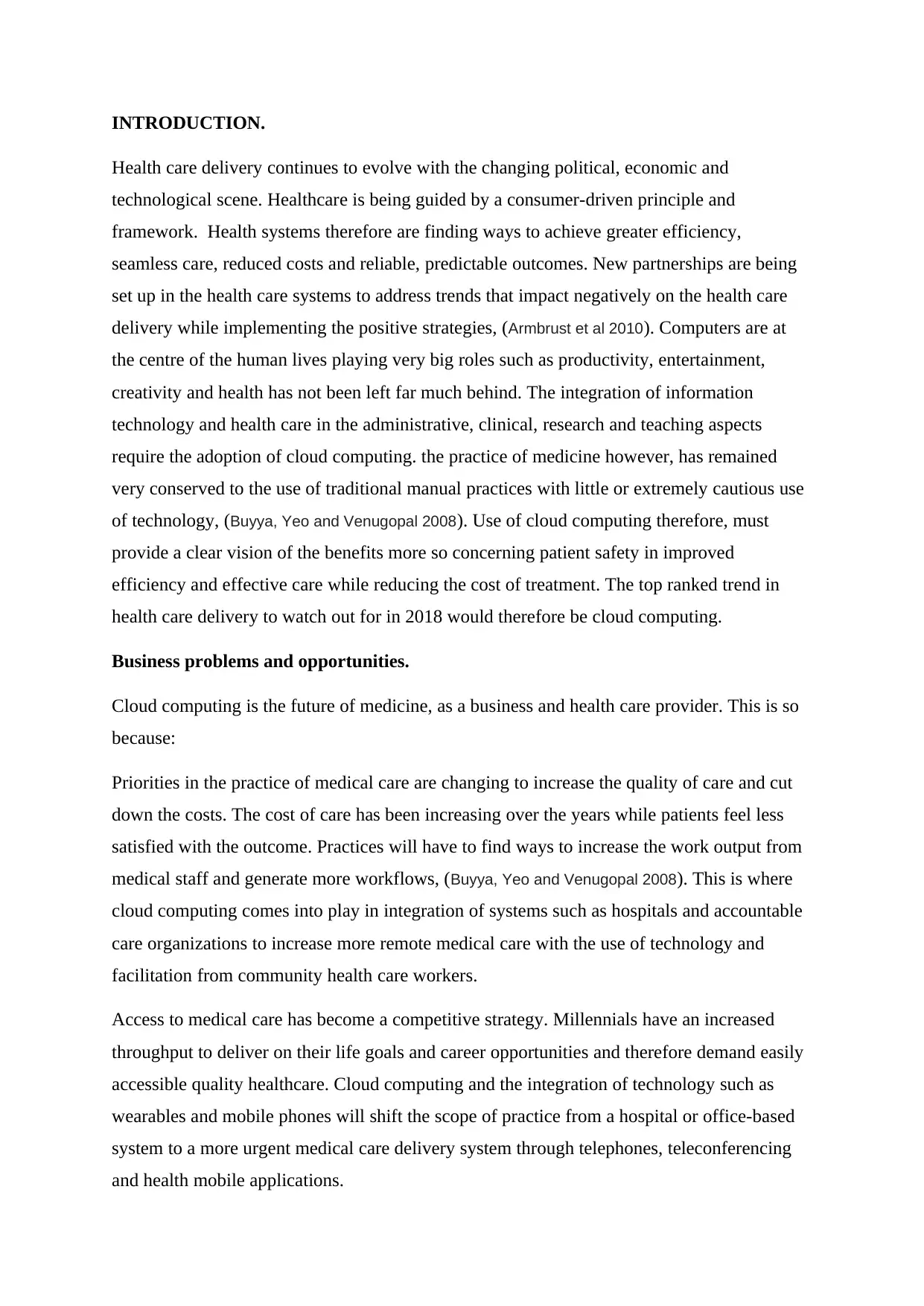
INTRODUCTION.
Health care delivery continues to evolve with the changing political, economic and
technological scene. Healthcare is being guided by a consumer-driven principle and
framework. Health systems therefore are finding ways to achieve greater efficiency,
seamless care, reduced costs and reliable, predictable outcomes. New partnerships are being
set up in the health care systems to address trends that impact negatively on the health care
delivery while implementing the positive strategies, (Armbrust et al 2010). Computers are at
the centre of the human lives playing very big roles such as productivity, entertainment,
creativity and health has not been left far much behind. The integration of information
technology and health care in the administrative, clinical, research and teaching aspects
require the adoption of cloud computing. the practice of medicine however, has remained
very conserved to the use of traditional manual practices with little or extremely cautious use
of technology, (Buyya, Yeo and Venugopal 2008). Use of cloud computing therefore, must
provide a clear vision of the benefits more so concerning patient safety in improved
efficiency and effective care while reducing the cost of treatment. The top ranked trend in
health care delivery to watch out for in 2018 would therefore be cloud computing.
Business problems and opportunities.
Cloud computing is the future of medicine, as a business and health care provider. This is so
because:
Priorities in the practice of medical care are changing to increase the quality of care and cut
down the costs. The cost of care has been increasing over the years while patients feel less
satisfied with the outcome. Practices will have to find ways to increase the work output from
medical staff and generate more workflows, (Buyya, Yeo and Venugopal 2008). This is where
cloud computing comes into play in integration of systems such as hospitals and accountable
care organizations to increase more remote medical care with the use of technology and
facilitation from community health care workers.
Access to medical care has become a competitive strategy. Millennials have an increased
throughput to deliver on their life goals and career opportunities and therefore demand easily
accessible quality healthcare. Cloud computing and the integration of technology such as
wearables and mobile phones will shift the scope of practice from a hospital or office-based
system to a more urgent medical care delivery system through telephones, teleconferencing
and health mobile applications.
Health care delivery continues to evolve with the changing political, economic and
technological scene. Healthcare is being guided by a consumer-driven principle and
framework. Health systems therefore are finding ways to achieve greater efficiency,
seamless care, reduced costs and reliable, predictable outcomes. New partnerships are being
set up in the health care systems to address trends that impact negatively on the health care
delivery while implementing the positive strategies, (Armbrust et al 2010). Computers are at
the centre of the human lives playing very big roles such as productivity, entertainment,
creativity and health has not been left far much behind. The integration of information
technology and health care in the administrative, clinical, research and teaching aspects
require the adoption of cloud computing. the practice of medicine however, has remained
very conserved to the use of traditional manual practices with little or extremely cautious use
of technology, (Buyya, Yeo and Venugopal 2008). Use of cloud computing therefore, must
provide a clear vision of the benefits more so concerning patient safety in improved
efficiency and effective care while reducing the cost of treatment. The top ranked trend in
health care delivery to watch out for in 2018 would therefore be cloud computing.
Business problems and opportunities.
Cloud computing is the future of medicine, as a business and health care provider. This is so
because:
Priorities in the practice of medical care are changing to increase the quality of care and cut
down the costs. The cost of care has been increasing over the years while patients feel less
satisfied with the outcome. Practices will have to find ways to increase the work output from
medical staff and generate more workflows, (Buyya, Yeo and Venugopal 2008). This is where
cloud computing comes into play in integration of systems such as hospitals and accountable
care organizations to increase more remote medical care with the use of technology and
facilitation from community health care workers.
Access to medical care has become a competitive strategy. Millennials have an increased
throughput to deliver on their life goals and career opportunities and therefore demand easily
accessible quality healthcare. Cloud computing and the integration of technology such as
wearables and mobile phones will shift the scope of practice from a hospital or office-based
system to a more urgent medical care delivery system through telephones, teleconferencing
and health mobile applications.
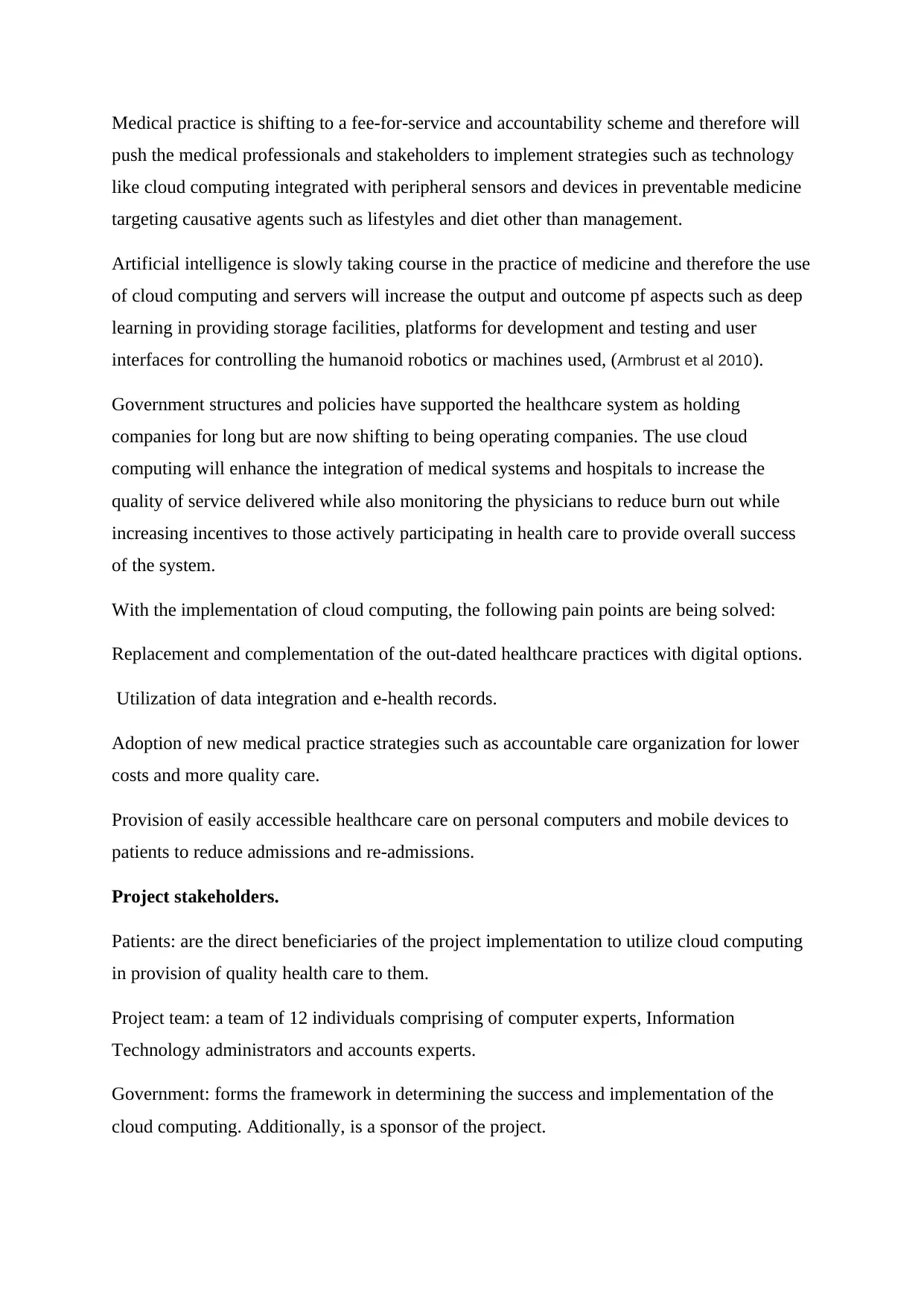
Medical practice is shifting to a fee-for-service and accountability scheme and therefore will
push the medical professionals and stakeholders to implement strategies such as technology
like cloud computing integrated with peripheral sensors and devices in preventable medicine
targeting causative agents such as lifestyles and diet other than management.
Artificial intelligence is slowly taking course in the practice of medicine and therefore the use
of cloud computing and servers will increase the output and outcome pf aspects such as deep
learning in providing storage facilities, platforms for development and testing and user
interfaces for controlling the humanoid robotics or machines used, (Armbrust et al 2010).
Government structures and policies have supported the healthcare system as holding
companies for long but are now shifting to being operating companies. The use cloud
computing will enhance the integration of medical systems and hospitals to increase the
quality of service delivered while also monitoring the physicians to reduce burn out while
increasing incentives to those actively participating in health care to provide overall success
of the system.
With the implementation of cloud computing, the following pain points are being solved:
Replacement and complementation of the out-dated healthcare practices with digital options.
Utilization of data integration and e-health records.
Adoption of new medical practice strategies such as accountable care organization for lower
costs and more quality care.
Provision of easily accessible healthcare care on personal computers and mobile devices to
patients to reduce admissions and re-admissions.
Project stakeholders.
Patients: are the direct beneficiaries of the project implementation to utilize cloud computing
in provision of quality health care to them.
Project team: a team of 12 individuals comprising of computer experts, Information
Technology administrators and accounts experts.
Government: forms the framework in determining the success and implementation of the
cloud computing. Additionally, is a sponsor of the project.
push the medical professionals and stakeholders to implement strategies such as technology
like cloud computing integrated with peripheral sensors and devices in preventable medicine
targeting causative agents such as lifestyles and diet other than management.
Artificial intelligence is slowly taking course in the practice of medicine and therefore the use
of cloud computing and servers will increase the output and outcome pf aspects such as deep
learning in providing storage facilities, platforms for development and testing and user
interfaces for controlling the humanoid robotics or machines used, (Armbrust et al 2010).
Government structures and policies have supported the healthcare system as holding
companies for long but are now shifting to being operating companies. The use cloud
computing will enhance the integration of medical systems and hospitals to increase the
quality of service delivered while also monitoring the physicians to reduce burn out while
increasing incentives to those actively participating in health care to provide overall success
of the system.
With the implementation of cloud computing, the following pain points are being solved:
Replacement and complementation of the out-dated healthcare practices with digital options.
Utilization of data integration and e-health records.
Adoption of new medical practice strategies such as accountable care organization for lower
costs and more quality care.
Provision of easily accessible healthcare care on personal computers and mobile devices to
patients to reduce admissions and re-admissions.
Project stakeholders.
Patients: are the direct beneficiaries of the project implementation to utilize cloud computing
in provision of quality health care to them.
Project team: a team of 12 individuals comprising of computer experts, Information
Technology administrators and accounts experts.
Government: forms the framework in determining the success and implementation of the
cloud computing. Additionally, is a sponsor of the project.
⊘ This is a preview!⊘
Do you want full access?
Subscribe today to unlock all pages.

Trusted by 1+ million students worldwide
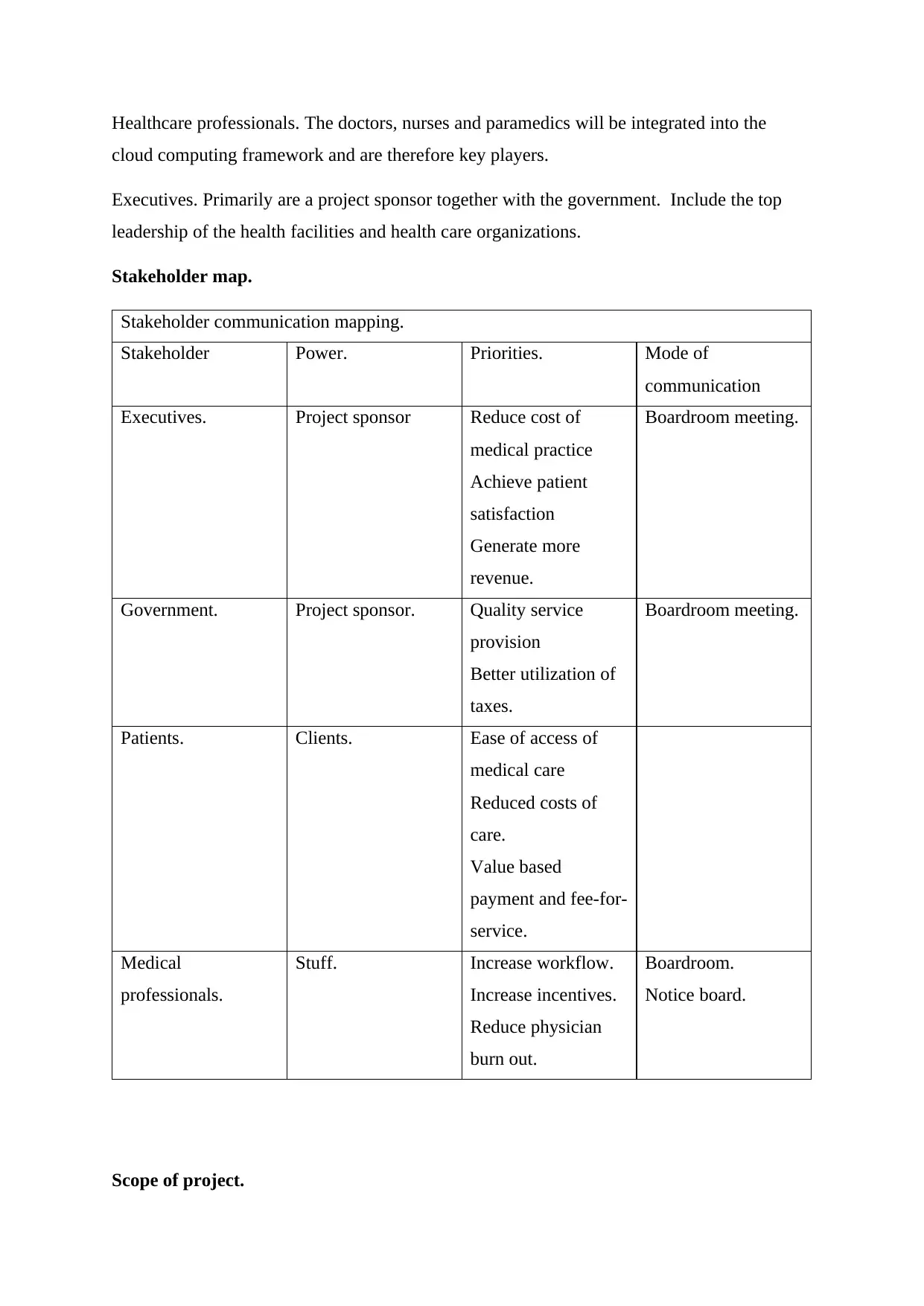
Healthcare professionals. The doctors, nurses and paramedics will be integrated into the
cloud computing framework and are therefore key players.
Executives. Primarily are a project sponsor together with the government. Include the top
leadership of the health facilities and health care organizations.
Stakeholder map.
Stakeholder communication mapping.
Stakeholder Power. Priorities. Mode of
communication
Executives. Project sponsor Reduce cost of
medical practice
Achieve patient
satisfaction
Generate more
revenue.
Boardroom meeting.
Government. Project sponsor. Quality service
provision
Better utilization of
taxes.
Boardroom meeting.
Patients. Clients. Ease of access of
medical care
Reduced costs of
care.
Value based
payment and fee-for-
service.
Medical
professionals.
Stuff. Increase workflow.
Increase incentives.
Reduce physician
burn out.
Boardroom.
Notice board.
Scope of project.
cloud computing framework and are therefore key players.
Executives. Primarily are a project sponsor together with the government. Include the top
leadership of the health facilities and health care organizations.
Stakeholder map.
Stakeholder communication mapping.
Stakeholder Power. Priorities. Mode of
communication
Executives. Project sponsor Reduce cost of
medical practice
Achieve patient
satisfaction
Generate more
revenue.
Boardroom meeting.
Government. Project sponsor. Quality service
provision
Better utilization of
taxes.
Boardroom meeting.
Patients. Clients. Ease of access of
medical care
Reduced costs of
care.
Value based
payment and fee-for-
service.
Medical
professionals.
Stuff. Increase workflow.
Increase incentives.
Reduce physician
burn out.
Boardroom.
Notice board.
Scope of project.
Paraphrase This Document
Need a fresh take? Get an instant paraphrase of this document with our AI Paraphraser
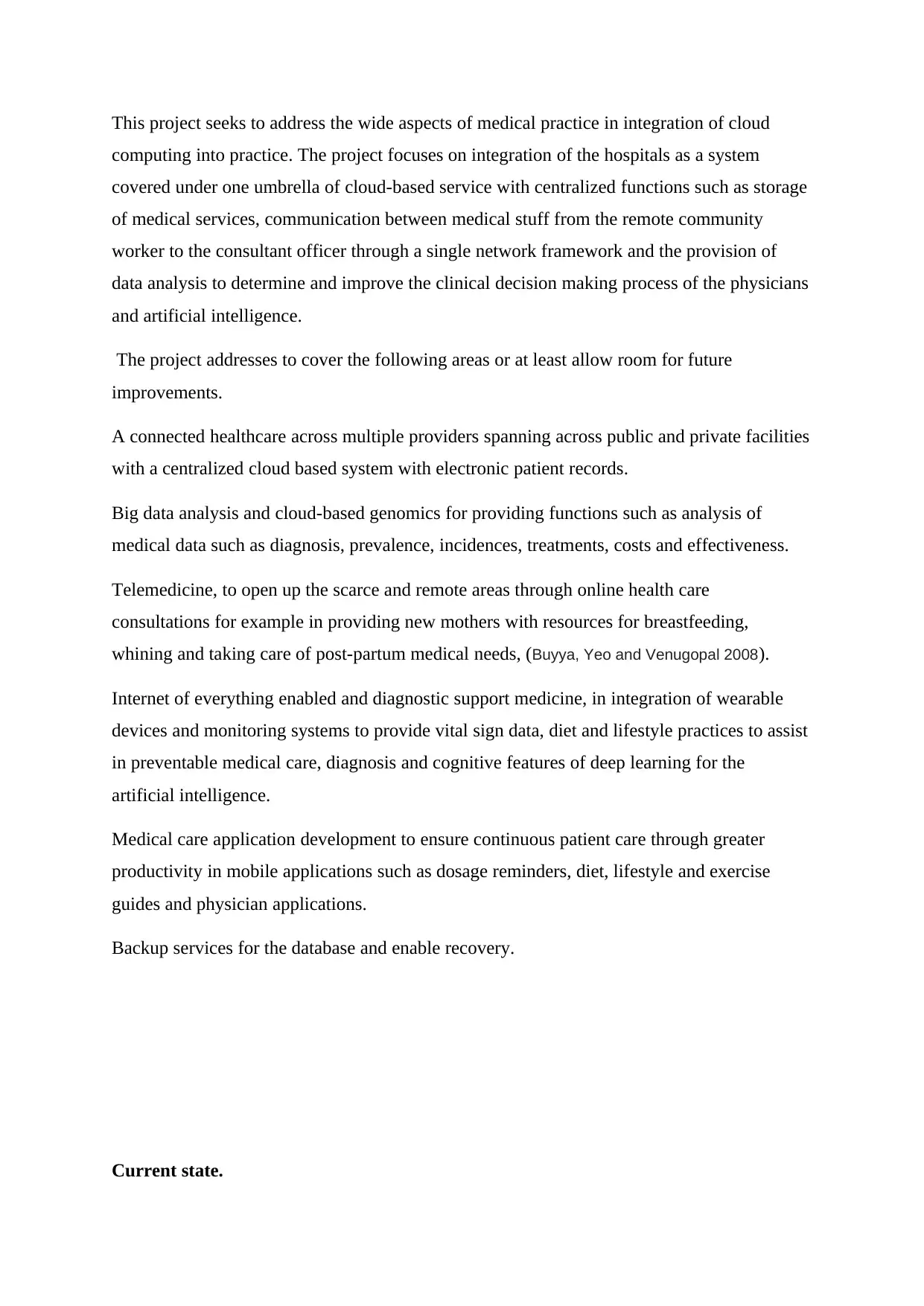
This project seeks to address the wide aspects of medical practice in integration of cloud
computing into practice. The project focuses on integration of the hospitals as a system
covered under one umbrella of cloud-based service with centralized functions such as storage
of medical services, communication between medical stuff from the remote community
worker to the consultant officer through a single network framework and the provision of
data analysis to determine and improve the clinical decision making process of the physicians
and artificial intelligence.
The project addresses to cover the following areas or at least allow room for future
improvements.
A connected healthcare across multiple providers spanning across public and private facilities
with a centralized cloud based system with electronic patient records.
Big data analysis and cloud-based genomics for providing functions such as analysis of
medical data such as diagnosis, prevalence, incidences, treatments, costs and effectiveness.
Telemedicine, to open up the scarce and remote areas through online health care
consultations for example in providing new mothers with resources for breastfeeding,
whining and taking care of post-partum medical needs, (Buyya, Yeo and Venugopal 2008).
Internet of everything enabled and diagnostic support medicine, in integration of wearable
devices and monitoring systems to provide vital sign data, diet and lifestyle practices to assist
in preventable medical care, diagnosis and cognitive features of deep learning for the
artificial intelligence.
Medical care application development to ensure continuous patient care through greater
productivity in mobile applications such as dosage reminders, diet, lifestyle and exercise
guides and physician applications.
Backup services for the database and enable recovery.
Current state.
computing into practice. The project focuses on integration of the hospitals as a system
covered under one umbrella of cloud-based service with centralized functions such as storage
of medical services, communication between medical stuff from the remote community
worker to the consultant officer through a single network framework and the provision of
data analysis to determine and improve the clinical decision making process of the physicians
and artificial intelligence.
The project addresses to cover the following areas or at least allow room for future
improvements.
A connected healthcare across multiple providers spanning across public and private facilities
with a centralized cloud based system with electronic patient records.
Big data analysis and cloud-based genomics for providing functions such as analysis of
medical data such as diagnosis, prevalence, incidences, treatments, costs and effectiveness.
Telemedicine, to open up the scarce and remote areas through online health care
consultations for example in providing new mothers with resources for breastfeeding,
whining and taking care of post-partum medical needs, (Buyya, Yeo and Venugopal 2008).
Internet of everything enabled and diagnostic support medicine, in integration of wearable
devices and monitoring systems to provide vital sign data, diet and lifestyle practices to assist
in preventable medical care, diagnosis and cognitive features of deep learning for the
artificial intelligence.
Medical care application development to ensure continuous patient care through greater
productivity in mobile applications such as dosage reminders, diet, lifestyle and exercise
guides and physician applications.
Backup services for the database and enable recovery.
Current state.
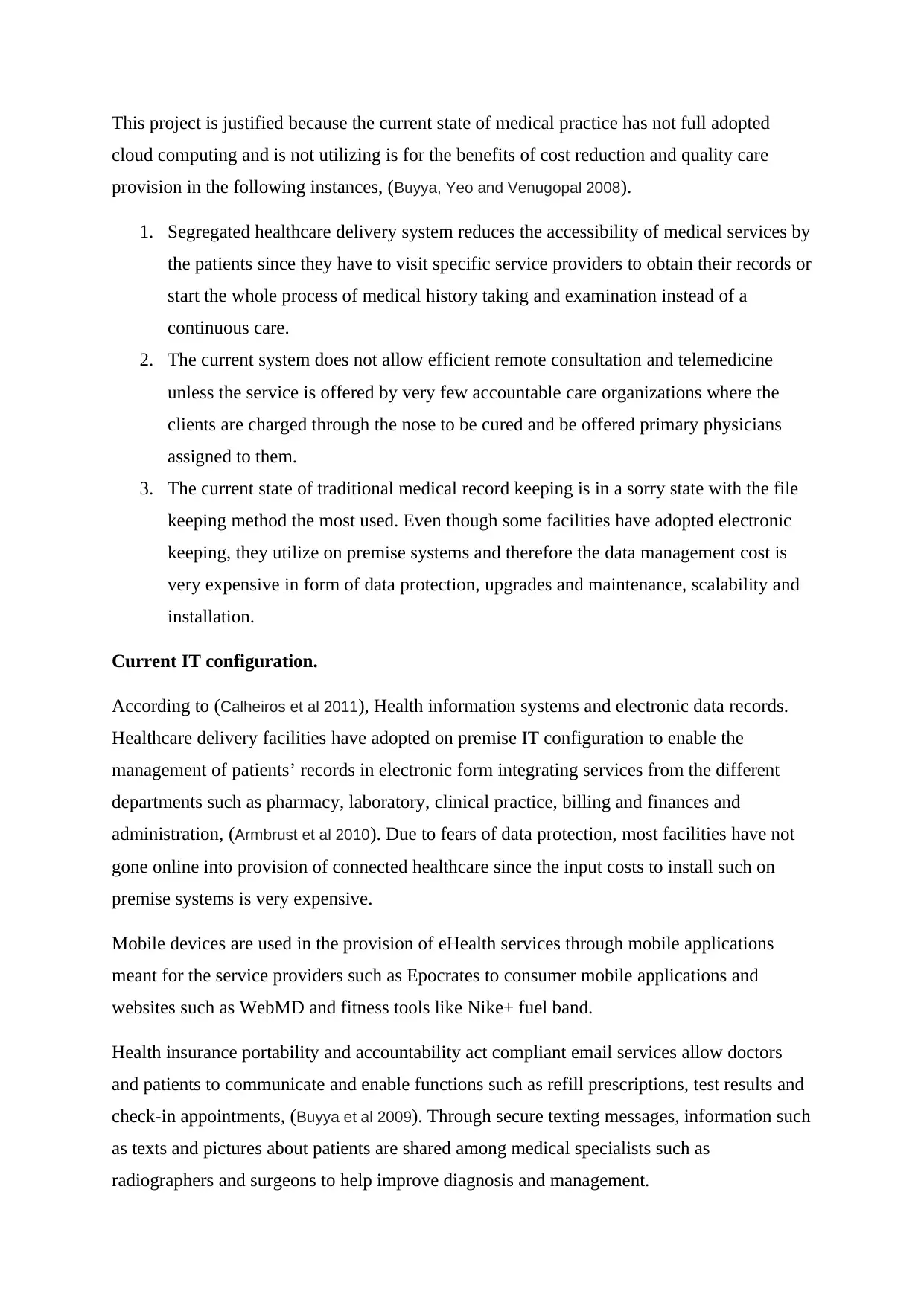
This project is justified because the current state of medical practice has not full adopted
cloud computing and is not utilizing is for the benefits of cost reduction and quality care
provision in the following instances, (Buyya, Yeo and Venugopal 2008).
1. Segregated healthcare delivery system reduces the accessibility of medical services by
the patients since they have to visit specific service providers to obtain their records or
start the whole process of medical history taking and examination instead of a
continuous care.
2. The current system does not allow efficient remote consultation and telemedicine
unless the service is offered by very few accountable care organizations where the
clients are charged through the nose to be cured and be offered primary physicians
assigned to them.
3. The current state of traditional medical record keeping is in a sorry state with the file
keeping method the most used. Even though some facilities have adopted electronic
keeping, they utilize on premise systems and therefore the data management cost is
very expensive in form of data protection, upgrades and maintenance, scalability and
installation.
Current IT configuration.
According to (Calheiros et al 2011), Health information systems and electronic data records.
Healthcare delivery facilities have adopted on premise IT configuration to enable the
management of patients’ records in electronic form integrating services from the different
departments such as pharmacy, laboratory, clinical practice, billing and finances and
administration, (Armbrust et al 2010). Due to fears of data protection, most facilities have not
gone online into provision of connected healthcare since the input costs to install such on
premise systems is very expensive.
Mobile devices are used in the provision of eHealth services through mobile applications
meant for the service providers such as Epocrates to consumer mobile applications and
websites such as WebMD and fitness tools like Nike+ fuel band.
Health insurance portability and accountability act compliant email services allow doctors
and patients to communicate and enable functions such as refill prescriptions, test results and
check-in appointments, (Buyya et al 2009). Through secure texting messages, information such
as texts and pictures about patients are shared among medical specialists such as
radiographers and surgeons to help improve diagnosis and management.
cloud computing and is not utilizing is for the benefits of cost reduction and quality care
provision in the following instances, (Buyya, Yeo and Venugopal 2008).
1. Segregated healthcare delivery system reduces the accessibility of medical services by
the patients since they have to visit specific service providers to obtain their records or
start the whole process of medical history taking and examination instead of a
continuous care.
2. The current system does not allow efficient remote consultation and telemedicine
unless the service is offered by very few accountable care organizations where the
clients are charged through the nose to be cured and be offered primary physicians
assigned to them.
3. The current state of traditional medical record keeping is in a sorry state with the file
keeping method the most used. Even though some facilities have adopted electronic
keeping, they utilize on premise systems and therefore the data management cost is
very expensive in form of data protection, upgrades and maintenance, scalability and
installation.
Current IT configuration.
According to (Calheiros et al 2011), Health information systems and electronic data records.
Healthcare delivery facilities have adopted on premise IT configuration to enable the
management of patients’ records in electronic form integrating services from the different
departments such as pharmacy, laboratory, clinical practice, billing and finances and
administration, (Armbrust et al 2010). Due to fears of data protection, most facilities have not
gone online into provision of connected healthcare since the input costs to install such on
premise systems is very expensive.
Mobile devices are used in the provision of eHealth services through mobile applications
meant for the service providers such as Epocrates to consumer mobile applications and
websites such as WebMD and fitness tools like Nike+ fuel band.
Health insurance portability and accountability act compliant email services allow doctors
and patients to communicate and enable functions such as refill prescriptions, test results and
check-in appointments, (Buyya et al 2009). Through secure texting messages, information such
as texts and pictures about patients are shared among medical specialists such as
radiographers and surgeons to help improve diagnosis and management.
⊘ This is a preview!⊘
Do you want full access?
Subscribe today to unlock all pages.

Trusted by 1+ million students worldwide
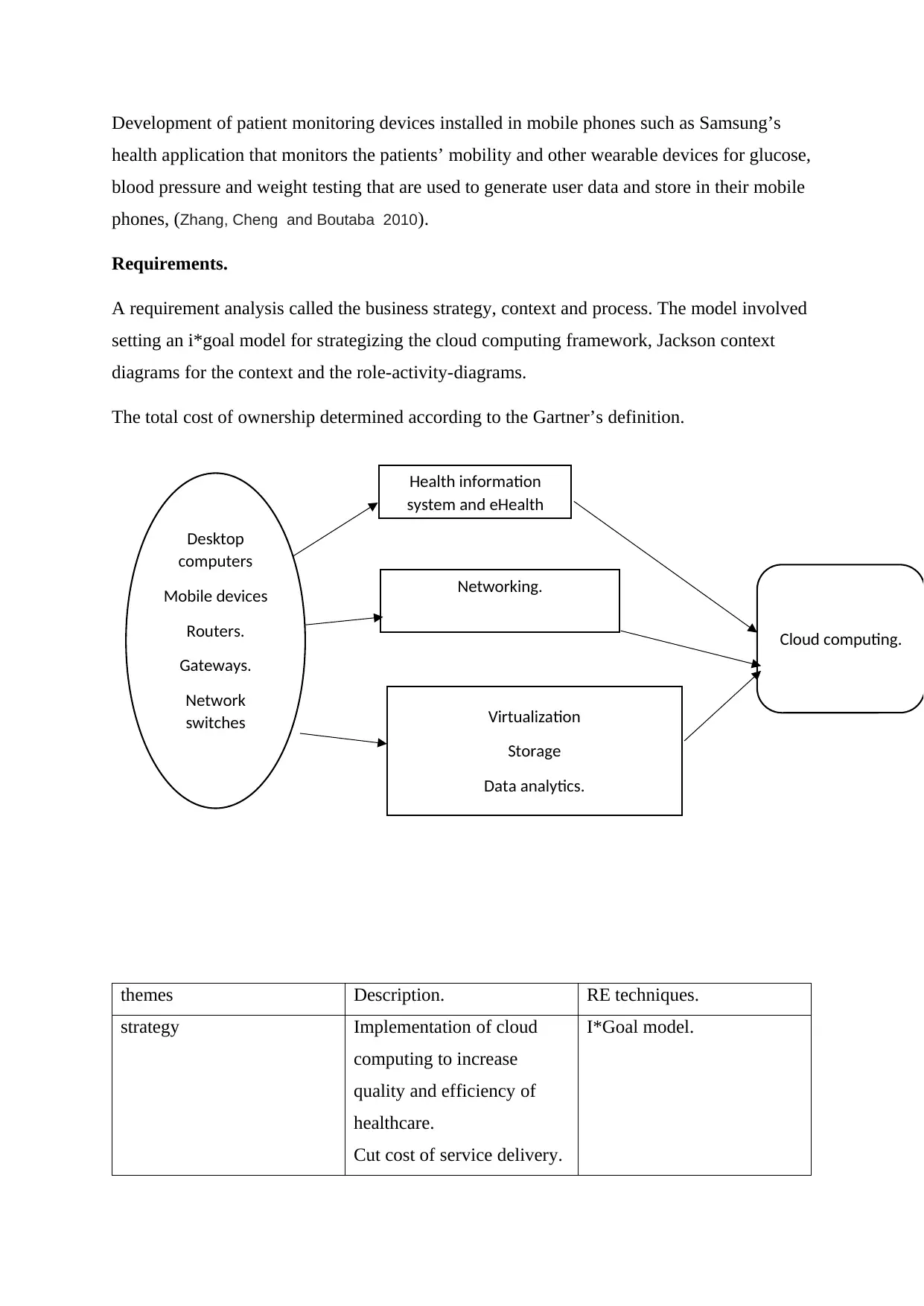
Development of patient monitoring devices installed in mobile phones such as Samsung’s
health application that monitors the patients’ mobility and other wearable devices for glucose,
blood pressure and weight testing that are used to generate user data and store in their mobile
phones, (Zhang, Cheng and Boutaba 2010).
Requirements.
A requirement analysis called the business strategy, context and process. The model involved
setting an i*goal model for strategizing the cloud computing framework, Jackson context
diagrams for the context and the role-activity-diagrams.
The total cost of ownership determined according to the Gartner’s definition.
themes Description. RE techniques.
strategy Implementation of cloud
computing to increase
quality and efficiency of
healthcare.
Cut cost of service delivery.
I*Goal model.
Desktop
computers
Mobile devices
Routers.
Gateways.
Network
switches
Health information
system and eHealth
Networking.
Virtualization
Storage
Data analytics.
Cloud computing.
health application that monitors the patients’ mobility and other wearable devices for glucose,
blood pressure and weight testing that are used to generate user data and store in their mobile
phones, (Zhang, Cheng and Boutaba 2010).
Requirements.
A requirement analysis called the business strategy, context and process. The model involved
setting an i*goal model for strategizing the cloud computing framework, Jackson context
diagrams for the context and the role-activity-diagrams.
The total cost of ownership determined according to the Gartner’s definition.
themes Description. RE techniques.
strategy Implementation of cloud
computing to increase
quality and efficiency of
healthcare.
Cut cost of service delivery.
I*Goal model.
Desktop
computers
Mobile devices
Routers.
Gateways.
Network
switches
Health information
system and eHealth
Networking.
Virtualization
Storage
Data analytics.
Cloud computing.
Paraphrase This Document
Need a fresh take? Get an instant paraphrase of this document with our AI Paraphraser
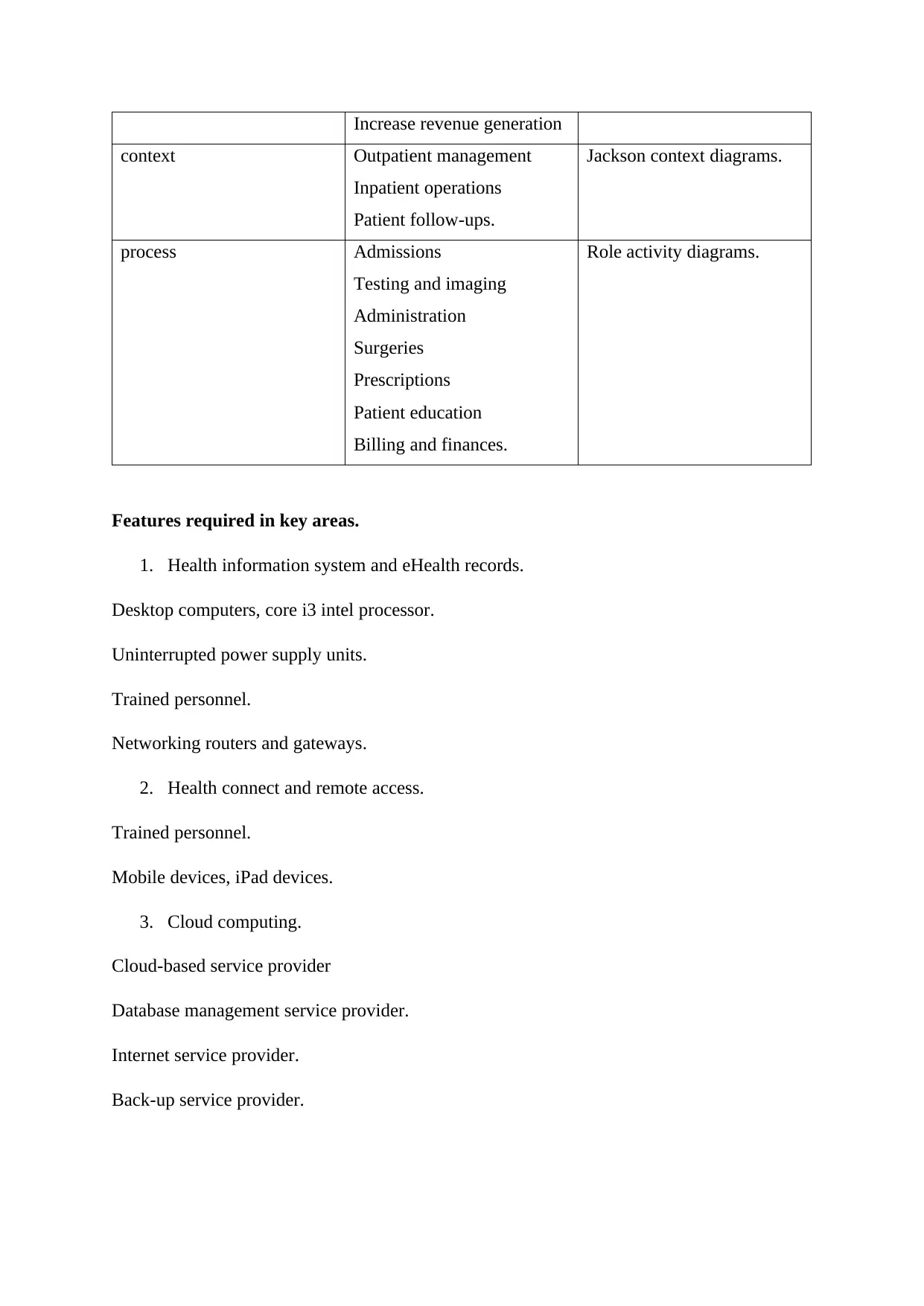
Increase revenue generation
context Outpatient management
Inpatient operations
Patient follow-ups.
Jackson context diagrams.
process Admissions
Testing and imaging
Administration
Surgeries
Prescriptions
Patient education
Billing and finances.
Role activity diagrams.
Features required in key areas.
1. Health information system and eHealth records.
Desktop computers, core i3 intel processor.
Uninterrupted power supply units.
Trained personnel.
Networking routers and gateways.
2. Health connect and remote access.
Trained personnel.
Mobile devices, iPad devices.
3. Cloud computing.
Cloud-based service provider
Database management service provider.
Internet service provider.
Back-up service provider.
context Outpatient management
Inpatient operations
Patient follow-ups.
Jackson context diagrams.
process Admissions
Testing and imaging
Administration
Surgeries
Prescriptions
Patient education
Billing and finances.
Role activity diagrams.
Features required in key areas.
1. Health information system and eHealth records.
Desktop computers, core i3 intel processor.
Uninterrupted power supply units.
Trained personnel.
Networking routers and gateways.
2. Health connect and remote access.
Trained personnel.
Mobile devices, iPad devices.
3. Cloud computing.
Cloud-based service provider
Database management service provider.
Internet service provider.
Back-up service provider.
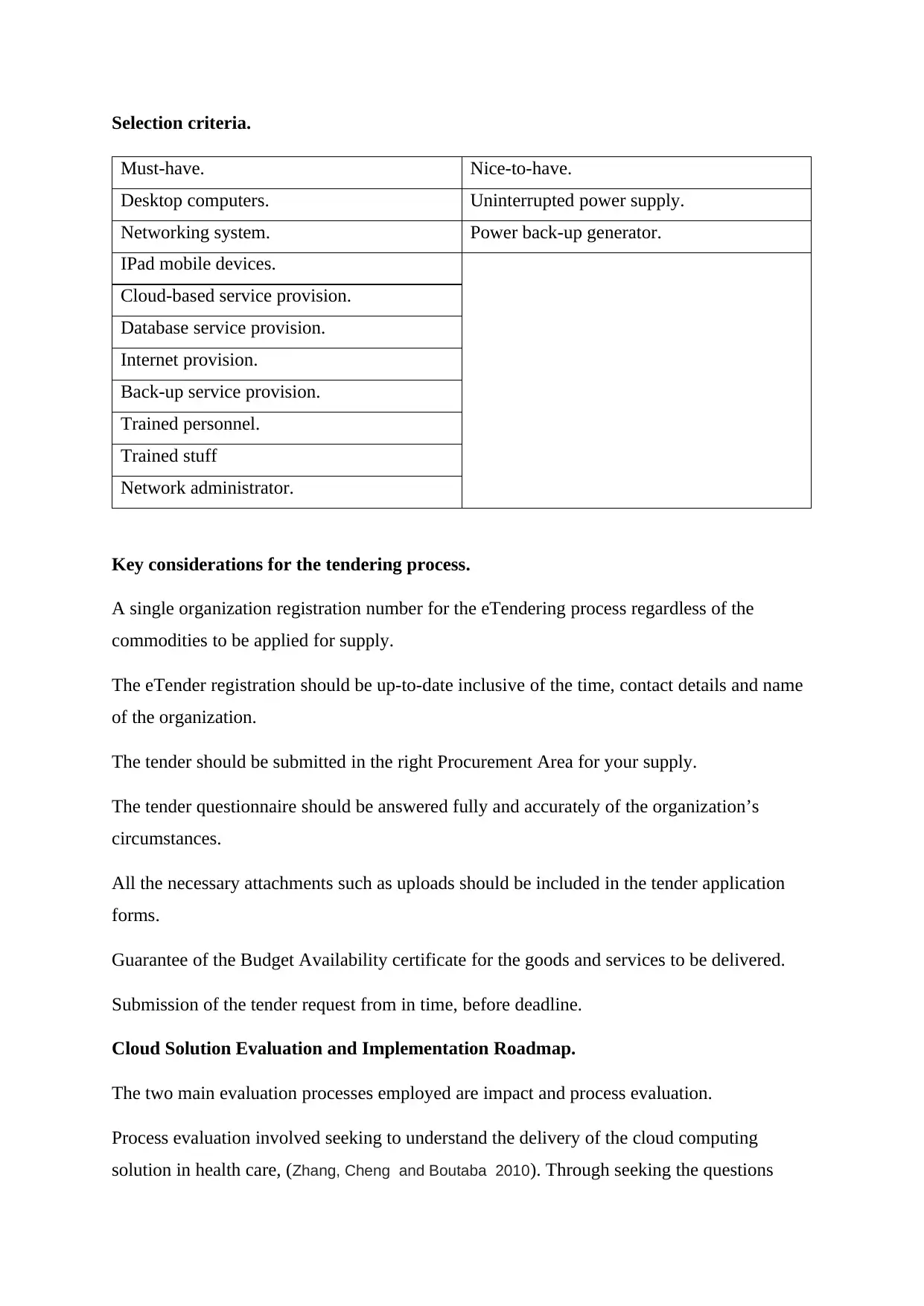
Selection criteria.
Must-have. Nice-to-have.
Desktop computers. Uninterrupted power supply.
Networking system. Power back-up generator.
IPad mobile devices.
Cloud-based service provision.
Database service provision.
Internet provision.
Back-up service provision.
Trained personnel.
Trained stuff
Network administrator.
Key considerations for the tendering process.
A single organization registration number for the eTendering process regardless of the
commodities to be applied for supply.
The eTender registration should be up-to-date inclusive of the time, contact details and name
of the organization.
The tender should be submitted in the right Procurement Area for your supply.
The tender questionnaire should be answered fully and accurately of the organization’s
circumstances.
All the necessary attachments such as uploads should be included in the tender application
forms.
Guarantee of the Budget Availability certificate for the goods and services to be delivered.
Submission of the tender request from in time, before deadline.
Cloud Solution Evaluation and Implementation Roadmap.
The two main evaluation processes employed are impact and process evaluation.
Process evaluation involved seeking to understand the delivery of the cloud computing
solution in health care, (Zhang, Cheng and Boutaba 2010). Through seeking the questions
Must-have. Nice-to-have.
Desktop computers. Uninterrupted power supply.
Networking system. Power back-up generator.
IPad mobile devices.
Cloud-based service provision.
Database service provision.
Internet provision.
Back-up service provision.
Trained personnel.
Trained stuff
Network administrator.
Key considerations for the tendering process.
A single organization registration number for the eTendering process regardless of the
commodities to be applied for supply.
The eTender registration should be up-to-date inclusive of the time, contact details and name
of the organization.
The tender should be submitted in the right Procurement Area for your supply.
The tender questionnaire should be answered fully and accurately of the organization’s
circumstances.
All the necessary attachments such as uploads should be included in the tender application
forms.
Guarantee of the Budget Availability certificate for the goods and services to be delivered.
Submission of the tender request from in time, before deadline.
Cloud Solution Evaluation and Implementation Roadmap.
The two main evaluation processes employed are impact and process evaluation.
Process evaluation involved seeking to understand the delivery of the cloud computing
solution in health care, (Zhang, Cheng and Boutaba 2010). Through seeking the questions
⊘ This is a preview!⊘
Do you want full access?
Subscribe today to unlock all pages.

Trusted by 1+ million students worldwide
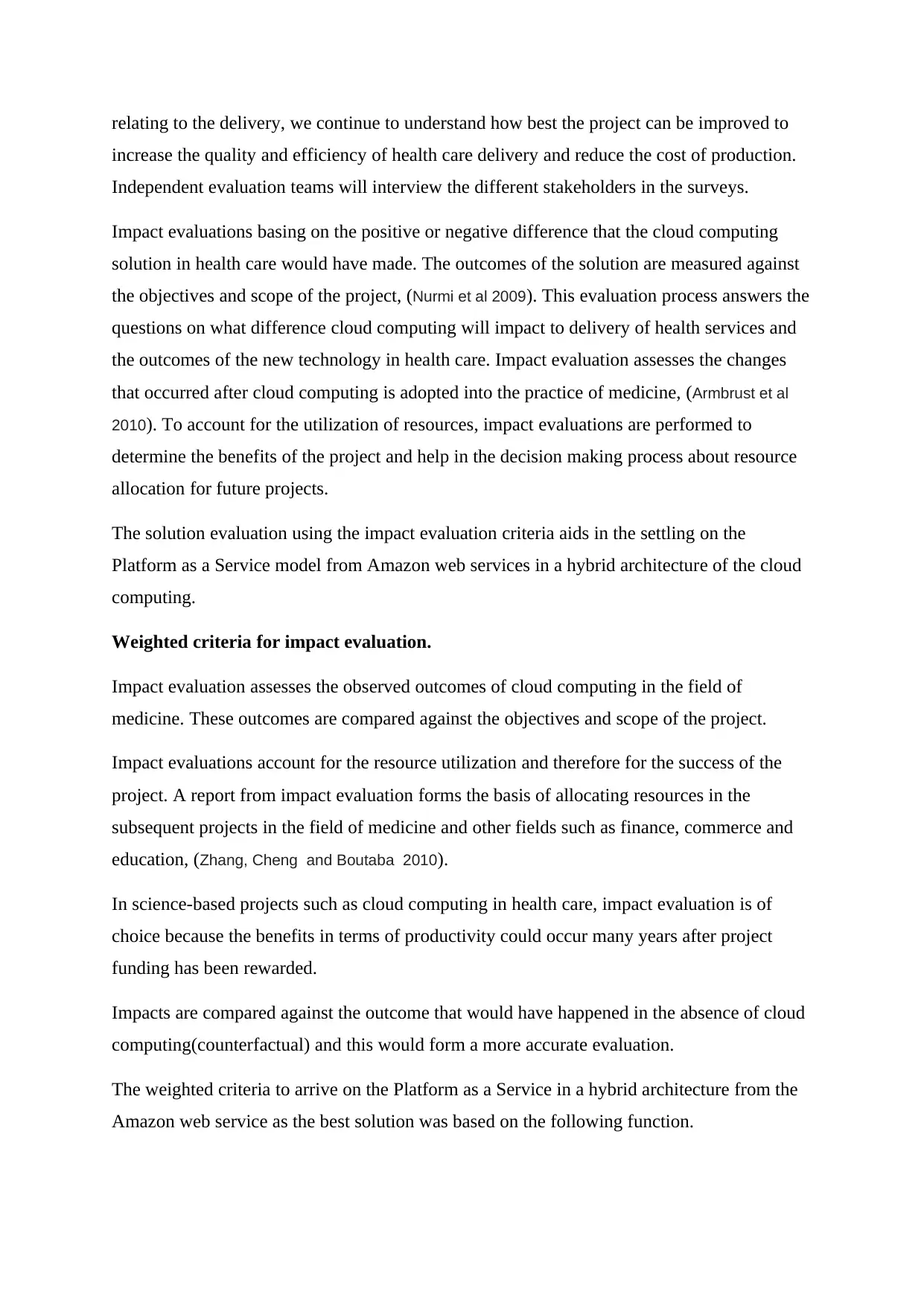
relating to the delivery, we continue to understand how best the project can be improved to
increase the quality and efficiency of health care delivery and reduce the cost of production.
Independent evaluation teams will interview the different stakeholders in the surveys.
Impact evaluations basing on the positive or negative difference that the cloud computing
solution in health care would have made. The outcomes of the solution are measured against
the objectives and scope of the project, (Nurmi et al 2009). This evaluation process answers the
questions on what difference cloud computing will impact to delivery of health services and
the outcomes of the new technology in health care. Impact evaluation assesses the changes
that occurred after cloud computing is adopted into the practice of medicine, (Armbrust et al
2010). To account for the utilization of resources, impact evaluations are performed to
determine the benefits of the project and help in the decision making process about resource
allocation for future projects.
The solution evaluation using the impact evaluation criteria aids in the settling on the
Platform as a Service model from Amazon web services in a hybrid architecture of the cloud
computing.
Weighted criteria for impact evaluation.
Impact evaluation assesses the observed outcomes of cloud computing in the field of
medicine. These outcomes are compared against the objectives and scope of the project.
Impact evaluations account for the resource utilization and therefore for the success of the
project. A report from impact evaluation forms the basis of allocating resources in the
subsequent projects in the field of medicine and other fields such as finance, commerce and
education, (Zhang, Cheng and Boutaba 2010).
In science-based projects such as cloud computing in health care, impact evaluation is of
choice because the benefits in terms of productivity could occur many years after project
funding has been rewarded.
Impacts are compared against the outcome that would have happened in the absence of cloud
computing(counterfactual) and this would form a more accurate evaluation.
The weighted criteria to arrive on the Platform as a Service in a hybrid architecture from the
Amazon web service as the best solution was based on the following function.
increase the quality and efficiency of health care delivery and reduce the cost of production.
Independent evaluation teams will interview the different stakeholders in the surveys.
Impact evaluations basing on the positive or negative difference that the cloud computing
solution in health care would have made. The outcomes of the solution are measured against
the objectives and scope of the project, (Nurmi et al 2009). This evaluation process answers the
questions on what difference cloud computing will impact to delivery of health services and
the outcomes of the new technology in health care. Impact evaluation assesses the changes
that occurred after cloud computing is adopted into the practice of medicine, (Armbrust et al
2010). To account for the utilization of resources, impact evaluations are performed to
determine the benefits of the project and help in the decision making process about resource
allocation for future projects.
The solution evaluation using the impact evaluation criteria aids in the settling on the
Platform as a Service model from Amazon web services in a hybrid architecture of the cloud
computing.
Weighted criteria for impact evaluation.
Impact evaluation assesses the observed outcomes of cloud computing in the field of
medicine. These outcomes are compared against the objectives and scope of the project.
Impact evaluations account for the resource utilization and therefore for the success of the
project. A report from impact evaluation forms the basis of allocating resources in the
subsequent projects in the field of medicine and other fields such as finance, commerce and
education, (Zhang, Cheng and Boutaba 2010).
In science-based projects such as cloud computing in health care, impact evaluation is of
choice because the benefits in terms of productivity could occur many years after project
funding has been rewarded.
Impacts are compared against the outcome that would have happened in the absence of cloud
computing(counterfactual) and this would form a more accurate evaluation.
The weighted criteria to arrive on the Platform as a Service in a hybrid architecture from the
Amazon web service as the best solution was based on the following function.
Paraphrase This Document
Need a fresh take? Get an instant paraphrase of this document with our AI Paraphraser
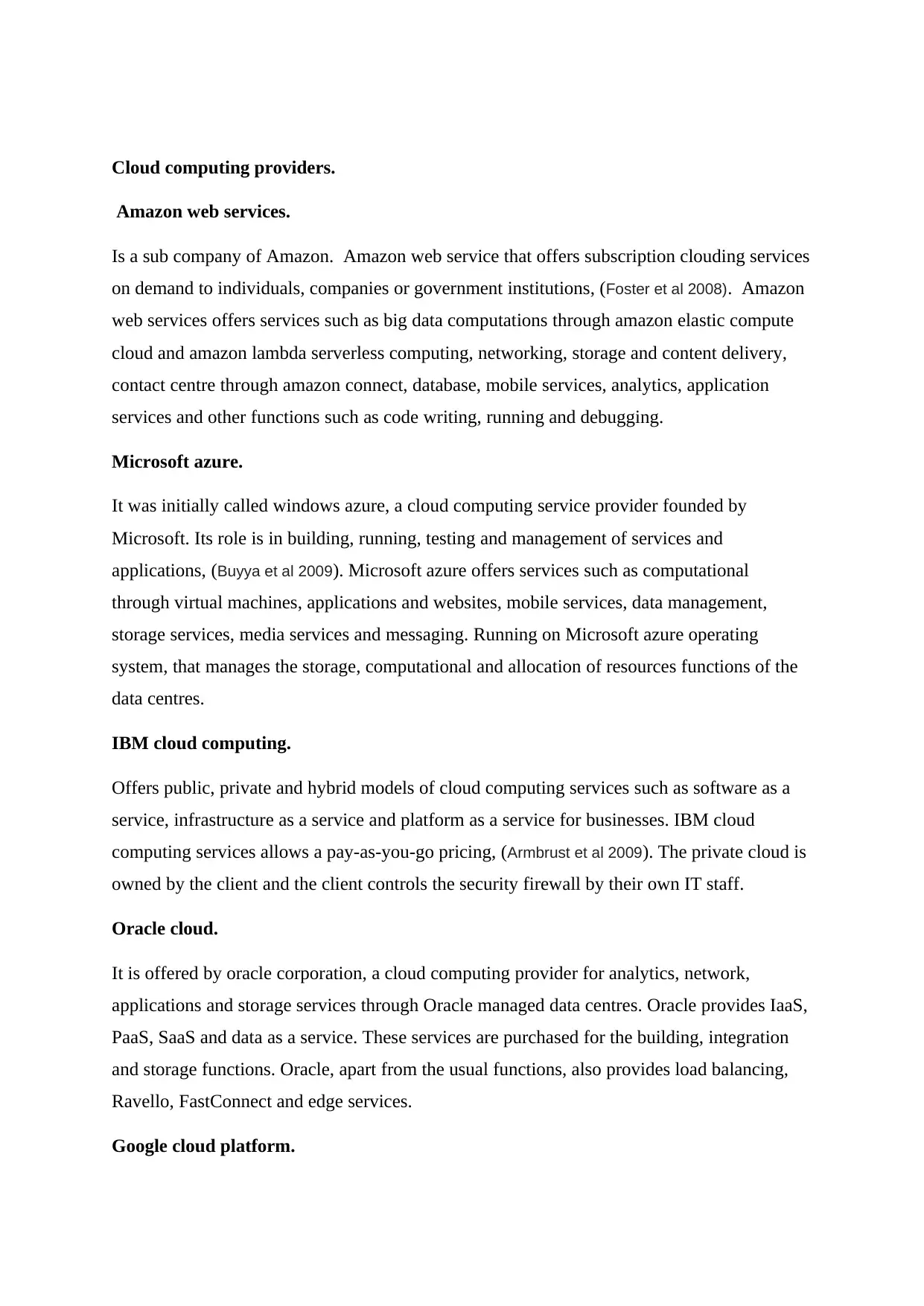
Cloud computing providers.
Amazon web services.
Is a sub company of Amazon. Amazon web service that offers subscription clouding services
on demand to individuals, companies or government institutions, (Foster et al 2008). Amazon
web services offers services such as big data computations through amazon elastic compute
cloud and amazon lambda serverless computing, networking, storage and content delivery,
contact centre through amazon connect, database, mobile services, analytics, application
services and other functions such as code writing, running and debugging.
Microsoft azure.
It was initially called windows azure, a cloud computing service provider founded by
Microsoft. Its role is in building, running, testing and management of services and
applications, (Buyya et al 2009). Microsoft azure offers services such as computational
through virtual machines, applications and websites, mobile services, data management,
storage services, media services and messaging. Running on Microsoft azure operating
system, that manages the storage, computational and allocation of resources functions of the
data centres.
IBM cloud computing.
Offers public, private and hybrid models of cloud computing services such as software as a
service, infrastructure as a service and platform as a service for businesses. IBM cloud
computing services allows a pay-as-you-go pricing, (Armbrust et al 2009). The private cloud is
owned by the client and the client controls the security firewall by their own IT staff.
Oracle cloud.
It is offered by oracle corporation, a cloud computing provider for analytics, network,
applications and storage services through Oracle managed data centres. Oracle provides IaaS,
PaaS, SaaS and data as a service. These services are purchased for the building, integration
and storage functions. Oracle, apart from the usual functions, also provides load balancing,
Ravello, FastConnect and edge services.
Google cloud platform.
Amazon web services.
Is a sub company of Amazon. Amazon web service that offers subscription clouding services
on demand to individuals, companies or government institutions, (Foster et al 2008). Amazon
web services offers services such as big data computations through amazon elastic compute
cloud and amazon lambda serverless computing, networking, storage and content delivery,
contact centre through amazon connect, database, mobile services, analytics, application
services and other functions such as code writing, running and debugging.
Microsoft azure.
It was initially called windows azure, a cloud computing service provider founded by
Microsoft. Its role is in building, running, testing and management of services and
applications, (Buyya et al 2009). Microsoft azure offers services such as computational
through virtual machines, applications and websites, mobile services, data management,
storage services, media services and messaging. Running on Microsoft azure operating
system, that manages the storage, computational and allocation of resources functions of the
data centres.
IBM cloud computing.
Offers public, private and hybrid models of cloud computing services such as software as a
service, infrastructure as a service and platform as a service for businesses. IBM cloud
computing services allows a pay-as-you-go pricing, (Armbrust et al 2009). The private cloud is
owned by the client and the client controls the security firewall by their own IT staff.
Oracle cloud.
It is offered by oracle corporation, a cloud computing provider for analytics, network,
applications and storage services through Oracle managed data centres. Oracle provides IaaS,
PaaS, SaaS and data as a service. These services are purchased for the building, integration
and storage functions. Oracle, apart from the usual functions, also provides load balancing,
Ravello, FastConnect and edge services.
Google cloud platform.
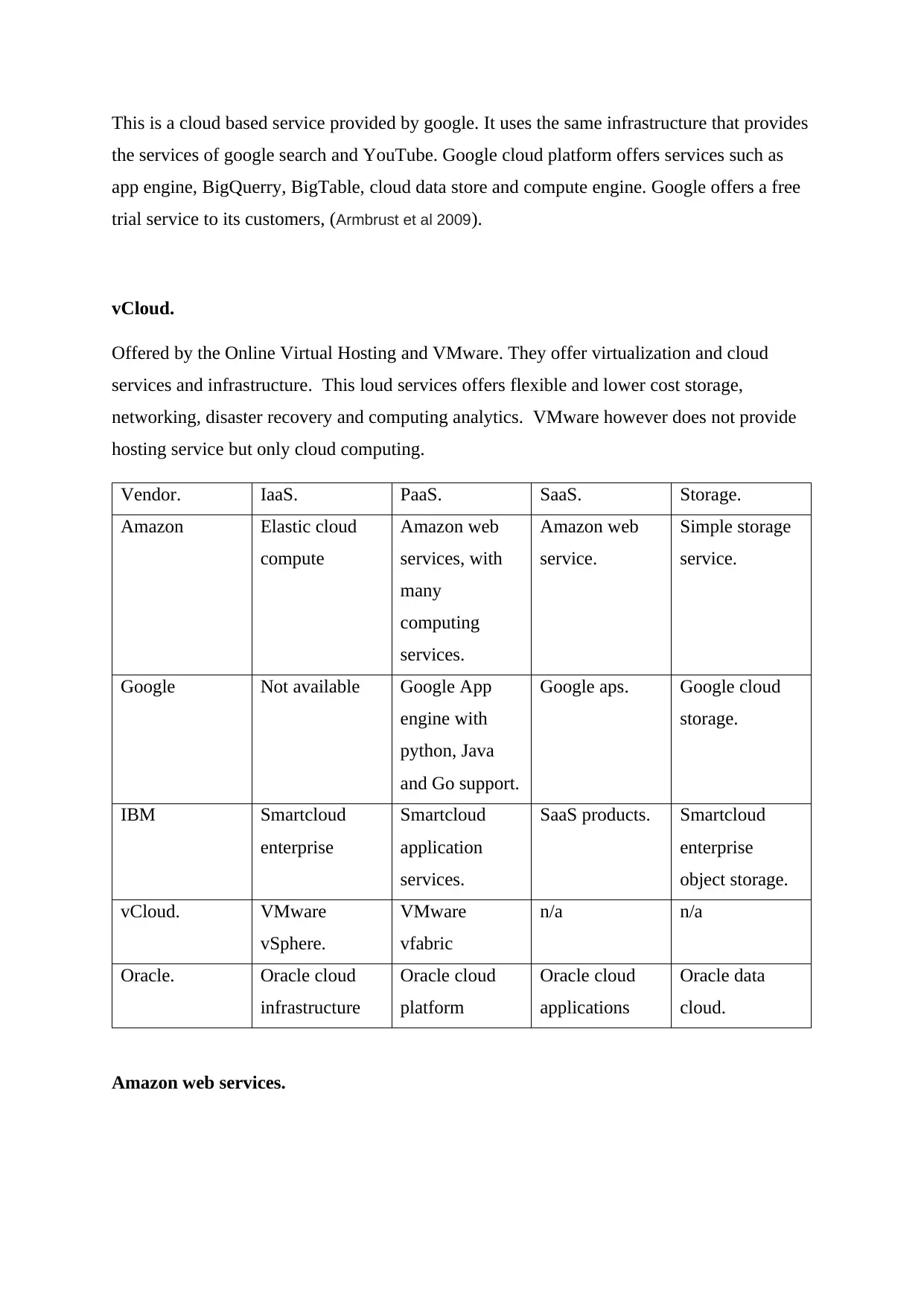
This is a cloud based service provided by google. It uses the same infrastructure that provides
the services of google search and YouTube. Google cloud platform offers services such as
app engine, BigQuerry, BigTable, cloud data store and compute engine. Google offers a free
trial service to its customers, (Armbrust et al 2009).
vCloud.
Offered by the Online Virtual Hosting and VMware. They offer virtualization and cloud
services and infrastructure. This loud services offers flexible and lower cost storage,
networking, disaster recovery and computing analytics. VMware however does not provide
hosting service but only cloud computing.
Vendor. IaaS. PaaS. SaaS. Storage.
Amazon Elastic cloud
compute
Amazon web
services, with
many
computing
services.
Amazon web
service.
Simple storage
service.
Google Not available Google App
engine with
python, Java
and Go support.
Google aps. Google cloud
storage.
IBM Smartcloud
enterprise
Smartcloud
application
services.
SaaS products. Smartcloud
enterprise
object storage.
vCloud. VMware
vSphere.
VMware
vfabric
n/a n/a
Oracle. Oracle cloud
infrastructure
Oracle cloud
platform
Oracle cloud
applications
Oracle data
cloud.
Amazon web services.
the services of google search and YouTube. Google cloud platform offers services such as
app engine, BigQuerry, BigTable, cloud data store and compute engine. Google offers a free
trial service to its customers, (Armbrust et al 2009).
vCloud.
Offered by the Online Virtual Hosting and VMware. They offer virtualization and cloud
services and infrastructure. This loud services offers flexible and lower cost storage,
networking, disaster recovery and computing analytics. VMware however does not provide
hosting service but only cloud computing.
Vendor. IaaS. PaaS. SaaS. Storage.
Amazon Elastic cloud
compute
Amazon web
services, with
many
computing
services.
Amazon web
service.
Simple storage
service.
Google Not available Google App
engine with
python, Java
and Go support.
Google aps. Google cloud
storage.
IBM Smartcloud
enterprise
Smartcloud
application
services.
SaaS products. Smartcloud
enterprise
object storage.
vCloud. VMware
vSphere.
VMware
vfabric
n/a n/a
Oracle. Oracle cloud
infrastructure
Oracle cloud
platform
Oracle cloud
applications
Oracle data
cloud.
Amazon web services.
⊘ This is a preview!⊘
Do you want full access?
Subscribe today to unlock all pages.

Trusted by 1+ million students worldwide
1 out of 23
Related Documents
Your All-in-One AI-Powered Toolkit for Academic Success.
+13062052269
info@desklib.com
Available 24*7 on WhatsApp / Email
![[object Object]](/_next/static/media/star-bottom.7253800d.svg)
Unlock your academic potential
Copyright © 2020–2025 A2Z Services. All Rights Reserved. Developed and managed by ZUCOL.





